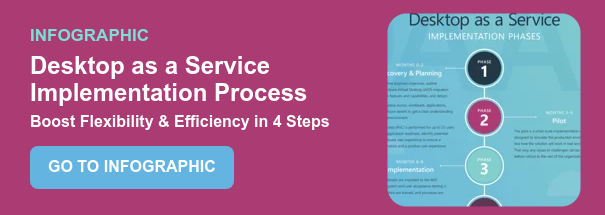What Is Desktop as a Service? Here’s What You Need to Know
Desktop as a Service (DaaS) empowers organizations to drive agility while delivering modern desktop experiences for every user. As a cloud computing offering that empowers organizations to embrace the modern workplace, DaaS can be implemented by companies to foster capabilities that support and manage short-term employees, mergers and acquisitions, work-from-anywhere teams, compliance standards, data access, and custom-developed applications—all while remaining secure despite mounting cybersecurity threats.
DaaS involves working with a service provider that helps you store virtual desktops in a Cloud environment while providing the necessary management to upkeep them. The provider handles maintenance and offers backend maintenance, backup, updates, and data storage, enabling your team to focus on other initiatives. But how exactly does DaaS work? In this blog, we’ll explore the benefits of Desktop as a Service, break down the steps to successfully implementing DaaS, and compare two popular DaaS solutions: Azure Virtual Desktop and Windows 365 Cloud PC. Let’s get started!
How DaaS Helps Organizations Solve Major Problems
Desktop as a Service offers several benefits that can help organizations address challenges and streamline their IT operations. From giving users the freedom to work from anywhere to offloading complex virtual desktop deployment, teams can rely on DaaS to improve their operations across touchpoints. Here are four of the greatest benefits associated with DaaS.
Reduce Risk
By consolidating all information and processes within the cloud and not the endpoint, DaaS enhances business continuity and allows organizations to protect data and control accessibility. Protect your endpoints from threats, avoid downtime, and provide secure access to data and apps. Not only does DaaS reduce security risks, but it also empowers companies to ensure compliance with industry standards by simplifying maintenance.
Enhance Flexibility
From improving the way employees work to making it easier to innovate, DaaS offers quick scalability that allows organizations to respond to disruption. For example, DaaS supports both remote and hybrid work, enabling your team to show up however works best for them.
Boost Productivity
DaaS also enables organizations to be more productive across every job function. From onboarding new users more quickly to empowering employees with modern work experiences, everyone can not only get to work faster but also finish their tasks more efficiently. Similarly, because DaaS offers improved efficiency, companies can accelerate the time to market, streamlining deployment, distribution, testing and development, collaboration, and scaling.
Optimize Costs
Investing in DaaS helps companies save money on remote desktop services (RDS) licenses and hardware upgrades as well as avoid the costs associated with hiring an entire internal company to run the IT and management of on-premise infrastructure. Along those lines, organizations can also optimize the cost of capital expenditures and operational expenditures—whether they’re expected or not.
At ProArch, we’ve seen how organizations have benefited from DaaS firsthand. For example, after one global client implemented DaaS through Azure Virtual Desktop, they not only accelerated their time to market but also reduced their security risk, improved elasticity to scale up or down, and drove operational efficiency through automation. This enabled them to deliver more agile service delivery and maximize their outcomes.
This is an excellent example of how organizations that can manage every aspect of their desktop environment in the cloud can overcome the limiting challenges thrown their way.
4 Steps to Successfully Rolling Out DaaS
The key to a successful DaaS rollout is breaking the implementation down into achievable, manageable steps. That way, you can ensure that each stage is executed well before moving on to the next one. Here are four key steps to include while executing Desktop as a Service.
1. Discovery, Planning, and Proof of Concept
Before implementing anything, it’s essential to set business objectives and KPIs, take inventory of workloads, and create a plan. Then, perform a proof of concept on a subset of workloads to establish a baseline of compatibility before rollout throughout the entire organization.
2. Pilot
After planning and performing a proof of concept, create an implementation plan and test it in one area. At this point, you’ll be able to identify roadblocks and potential errors before they affect the entire project. This will ensure performance and minimize disruption when full deployment occurs.
3. Implementation
A successful pilot paves the way for full implementation of the DaaS tool across your enterprise. Perform systems and user acceptance testing, train administrators, and document all relevant information to overcome any challenges.
4. Go-Live and Managed Services
Ongoing maintenance, patching, upgrades, troubleshooting, and optimization are essential to a successful DaaS implementation. From offering security to improving costs, alert monitoring and expert management will help you achieve your top objectives and protect your organization while doing so.
ProArch delivers these four steps to ensure the DaaS infrastructure is reliable while customizing the solution to an organization’s unique needs. For example, with one client, this meant not only moving 4,000 users to AVD but also modernizing and packaging 500 applications to ensure the team had everything it needed to excel.
Azure Virtual Desktop vs. Windows 365 Cloud PC
Azure Virtual Desktop (AVD) and Windows 365 are two of the most popular cloud-based DaaS tools on the market. While both solutions offer similar functionality, their costs, scope, features, and intended use cases vary significantly. Here’s how they compare.
Cost and Scope
First of all, AVD and Windows 365 Cloud PC vary in their cost models and scopes. AVD is a client-defined DaaS solution, which means a company has greater control over which services it utilizes. Because of this, it is billed based on an organization’s consumption rather than on a fixed-price model. On the other hand, Windows 365 Cloud PC is vendor-defined, as it’s considered a software-as-a-service solution. It offers a fixed per-user cost model and is billed at a flat rate.
While AVD is often a better fit for organizations that consider cost above all other factors or experience high fluctuations in the number of desktops needed in a month, Windows 365 Cloud PC works well for those that have fewer than 10 desktops and need personalized desktops for every user.
Features
Both AVD and Windows 365 offer secure delivery. However, Azure offers greater flexibility and customization capabilities. While this can make it harder to set up, the full configuration allows organizations to cater services to their greatest needs, handle high-performance workloads, and drive cost efficiency. The following are some of the primary features included in AVD:
- Multisession Windows 11 or Windows 10 deployment that delivers a scalable Windows experience
- Virtualize both desktops and apps
- Bring existing remote desktop services and apps to any computer
- Manage desktops and apps from various Windows and Windows Server operating systems
- Create a unified management experience with image, app, and profile management
In comparison, Windows 365 Cloud PC has Business and Enterprise plan options with varying features. Windows 365 Business is made for smaller companies with up to 300 seats that are looking for simple management options. Windows 365 Enterprise is designed for larger companies that want unlimited seats for cloud desktops and to create custom Cloud PCs. Unlike AVD, Cloud PC is managed completely by Microsoft, which means there are fewer opportunities for customization.
Intended Use Cases
Companies must carefully consider which DaaS option is best for them based on their unique needs and use cases. Here’s how AVD and Cloud PC use cases break down:
The vast majority of DaaS clients can drive greater value from AVD than Cloud PC. Here are a few examples of use cases where Azure is a great choice:
- Multi-user needs
- Legacy applications
- High-powered computing
- Full customization of the virtual environment
On the other hand, Cloud PC can be a good option for workforces that must control their costs. For example, the following use cases reflect some use cases that are relevant to Windows 365:
- Environments where employees need to use their own PCs
- Temporary work while devices are repaired
- Situations where organizations do not have access to the talent to manage the cloud PC
Overall, AVD is usually the best choice for organizations, as it allows them to customize the DaaS solution to their needs.
ProArch: Your DaaS Partner
At ProArch, we’re more than a simple DaaS provider, Not only do we manage applications and OS updates, but we also help you build robust security hardening policies, integrate with managed detection and response (MDR), and optimize your costs.
Are you ready to invest in DaaS and rely on an excellent solution that enables you to scale or change at a moment’s notice? Learn more about ProArch’s Desktop as a Service (DaaS) to discover how we can help your organization move to the cloud with confidence in as little as three months and four steps.

Director of Marketing Rebecca leads ProArch's marketing efforts, seamlessly blending technology and storytelling to assist clients in their buying journey. She is dedicated to presenting technological solutions in a compelling manner that drives significant growth for the company. Collaborating closely with sales, engineering, leadership, and HR teams, Rebecca sets the strategic vision for ProArch and ensures alignment across the organization. Her strategic, visionary, and detail-oriented approach shapes ProArch’s brand to be synonymous with reimagining technology to achieve business objectives.



